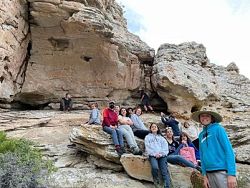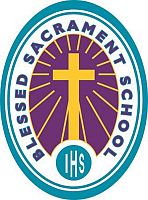Blessed Sacrament students learn science in the field

John McHugh
The seventh- and eighth-grade students at Blessed Sacrament Catholic School in Sandy had an outstanding science trip in the Vernal area May 10-12. They took part in guided field experiences in archaeology, geology, geomorphology and paleontology, which were chaperoned by science teacher John McHugh, fourth-grade teacher Kealey Johnson and Principal Bryan Penn.
The trip began with a lesson in geomorphology led by retired Bureau of Land Management hydrologist Darlene Koerner. Students walked the site of a 2018 fire that burned 60,000 acres of land near Fruitland and witnessed how the absence of vegetation resulted in soil erosion so vast it plugged up a large meandering mountain stream, resulting in the creation of a new body of water known as Duchesne Lake.
From there the students segued into archaeology, where McHugh, a professional archaeologist, guided them to a 1,000-year-old Native American pictograph. Pupils learned that this pictograph was a calendar site that marked the summer solstice, and was the basis for a published scientific paper in the research journal Archaeoastronomy and Ancient Technologies. At two additional archaeological sites, the students saw how the prehistoric Fremont Indians made a living, fed and raised their families, and lived at one with the natural world.
The middle-schoolers were led on a tour of the paleontology lab at the Utah Field House of Natural History State Park Museum by paleontologist John Foster. They saw the complex process by which a dinosaur skeleton is identified in the field and removed bone by bone in giant plaster casts, then transported to the lab. Students watched Diplodocus femurs and tail bones being cleaned of rock debris and joined with epoxy to reconstruct a complete skeleton ready to be seen by museum-goers.
The class also toured the main fossil bed at Dinosaur National Monument, led by paleontologist Rebecca Foster, who showed the middle-schoolers a fossil layer chock full of dinosaur bones that were entirely encased in the sandstone cliffs. The tour gave students an appreciation for the full cycle of fossil processing from its find in the field to cataloging, transport, years of cleaning and rejoining of broken bone pieces in the lab, until finally being erected as a museum display.
On the final day the science class visited the McConkie Ranch archaeological site, which has hundreds of prehistoric Native American rock art panels. Most of the petroglyphs and pictograph images were pecked and painted by the Fremont Indians, archaic agriculturalists who inhabited the land between 300-1400 AD. The students met rancher Jeannie McConkie (who is Catholic) and were given a tour of her family’s private museum at the site. Each child also got to climb down a ladder into a pithouse, the Fremont Indians’ circular, underground domicile.
The experience was so scientifically and culturally enriching that Principal Bryan Penn plans to make such “field work” the working model for the school’s science curriculum in 2022-23, he said.
John McHugh is a science teacher at Blessed Sacrament Catholic School.
© Copyright 2024 The Diocese of Salt Lake City. All rights reserved.


Stay Connected With Us